#David Zeb Cook
Text
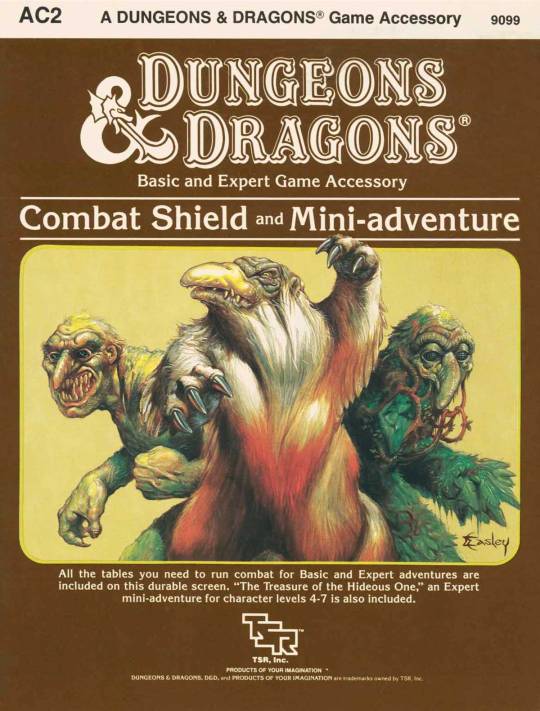
The Combat Shield and Mini-adventure for Basic and Expert D&D served the same role as AD&D's DM screen, with art by Jeff Easley facing the players along with the PC experience tables for level advancement, and important tables for the DM on the opposite side (TSR, 1984). This was for the 1983 3rd version of Basic D&D and 2nd version of Expert, to which TSR added Companion in 1984, followed by Master and Immortal Rules in the following 2 years to complete the "BECMI" D&D set.
The 8-page adventure "The Treasure of the Hideous One" by David Cook includes a full page scroll of backstory in tiny italic text, which seems an unnecessarily tedious way to begin a short adventure.
#D&D#Dungeons & Dragons#Jeff Easley#Combat Shield & Mini-adventure#BECMI#owlbear#troll#shambling mound#dnd#DM screen#Expert D&D#Dungeons and Dragons#David Cook#David Zeb Cook#Zeb Cook#1980s#TSR
146 notes
·
View notes
Text
Zeb Cook’s Player Types
I recently remembered this AD&D 2e module. It’s written by David “Zeb” Cook who some may know as the author of the original D&D expert set.

It’s most interesting to me because of the section title “the great treasure”, wherein Cook discusses how to cater the rewards and treasures of this campaign to different kinds of players.
He describes 5 different player types.
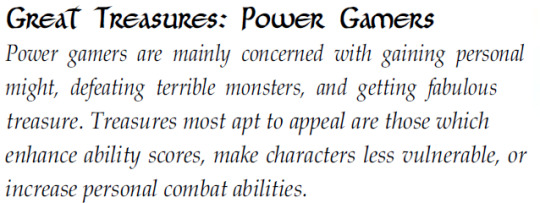
It’s important to note, he’s talking about each player type in the context of the kinds of treasures that these players might like.
It’s also worth noting that Cook described these as “styles of play” a term that has a completely different meaning today, referring to the style of the overall campaign and how the rules support that style, rather than a way that a player plays the game.

Warlords appear to be a kind of player that isn’t as well accommodated in something like 5e, with the absence of the old stronghold rules.
However some might argue this isn’t accommodated in OD&D and Basic D&D either, since in some games, you were supposed to retire a character once they became a monarch.

This one interests me most because I’m wondering how long Cook had known about this kind of player. Was it very common to see players who played this way?
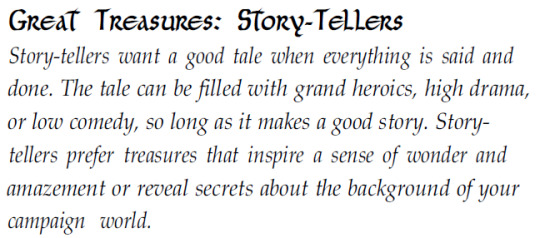
On “The Storyteller” I believe this one is not named correctly and reading the description, I feel “story-reader” is more appropriate, since it doesn’t appear like they actually want to tell stories as their character.
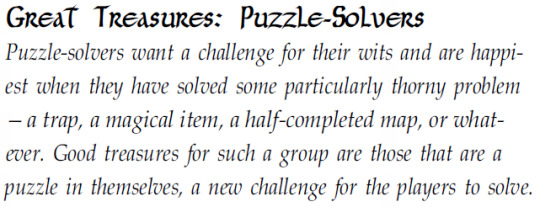
Interesting that the rewards for puzzle solvers are simply more puzzles. This one is cool because I feel this kind of player would enjoy “solving” a dungeon.
And there you have it.
Tag yourself for which one you think you are.
#David Zeb Cook#Cook#D&D Expert#AD&D 2e#TTRPG#D&D#Old-School#OSR#I feel like I have a bit of all of these in me#perhaps right now I lean closer to the puzzle solver
14 notes
·
View notes
Text
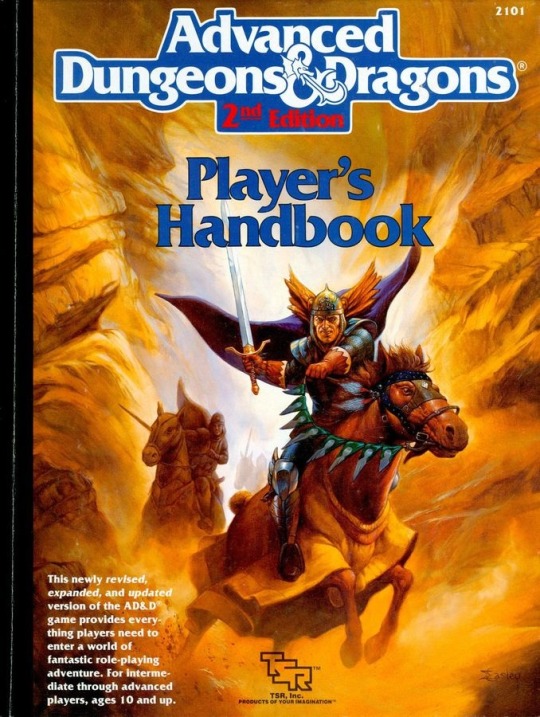

"The second edition of AD&D was finally released in early 1989. Many of the changes turned out to be cosmetic. One of the biggest was that the sizes of the Player’s Handbook (1989) and Dungeon Master’s Guide (1989) were reversed. Back in 1978 Gygax had decided that it was best if the players did not know the rules, and so the original Player’s Handbook was a skeleton that didn’t even detail combat. Now the entire roleplaying industry had accepted the fact that players and gamemasters were united in games — not adversaries — and the new rules reflected this. [...]
Perhaps most surprisingly, the rules were once again presented as “guidelines” — a reversal from Gygax’s original goal for the AD&D lines. Finally, the character classes were indeed cleaned up, with Arneson’s assassin and monk eliminated.
Though Cook had said that assassins were removed due to problems of party unity, their excision has always been seen by the public as part of TSR’s well-documented attempt to make AD&D more public friendly — TSR’s only allowance to the religious hysteria that had shadowed the game throughout the 1980s. Half-orcs were similarly removed as player characters, and demons and devils were eliminated entirely.


James M. Ward, who had instituted the removal of demons and devils, explained in Dragon #154 (February 1990) that “[a]voiding the Angry Mother Syndrome has become a good, basic guideline for all of the designers and editors at TSR, Inc.” Apparently, TSR had received one letter a week complaining about the demons and devils since the original Monster Manual was printed, and those 624 letters, or what Ward called “a lot of letters,” had been the reason he’d removed the infernal races.
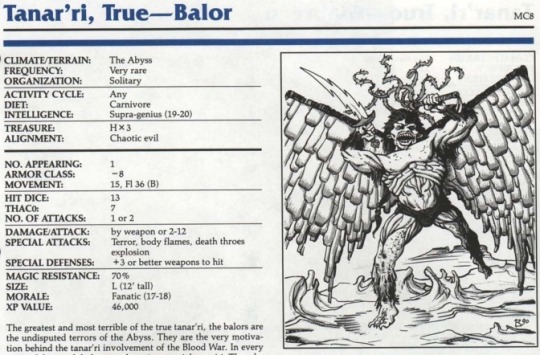

The readers were not amused, and to his credit Ward printed many of their replies in Dragon #158 (June 1990). One reader stated that the decision “becomes censorship when an outside group dictates to you … what you should print.” The release of the Outer Planes Appendix (1991) for the Monstrous Compendium assuaged some of the anger because it restored demons as “tanar’ri” and devils as “baatezu,” but some fans left D&D entirely as a result of this decision."
— Shannon Appelcline, Designers & Dragons: The ’70s
#d&d history#Shannon Appelcline#Designers & Dragons#tsr#gary gygax#ad&d#ad&d 2e#assassin#monk#fiend#David “Zeb” Cook#James M. Ward#information wants to be free
22 notes
·
View notes
Text
400. David "Zeb" Cook - AC3 (but really AC8): The Revenge of Rusak (1985)
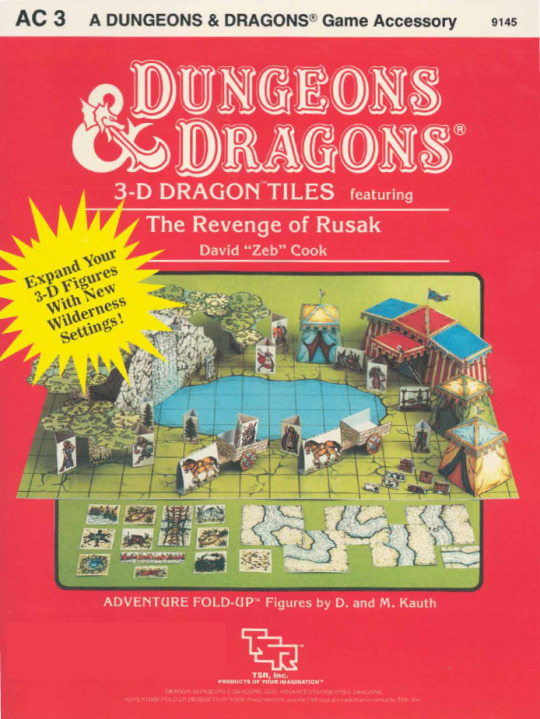
First of all let's address the elephant sized typo on the cover, this is not AC3 (which was The Kidnapping of Princess Arelina from 1984) but AC8 which can make it a bit confusing. Interestingly, and even more confusingly, this is a direct sequel to AC3 in terms of the adventure that comes bundled in with the models.

The idea of this AC (which stands for accessory) module is to provide players and DMs with some 3-D modules that can be used in play, in this case specifically for wilderness adventures. AC3 did something similar but with dungeon 3-D models then. This tradition comes all the way back from the beginning of D&D with the Dungeon Geomorphs and remains to our days with the Terrain Campaign Case that came out a couple of years ago.
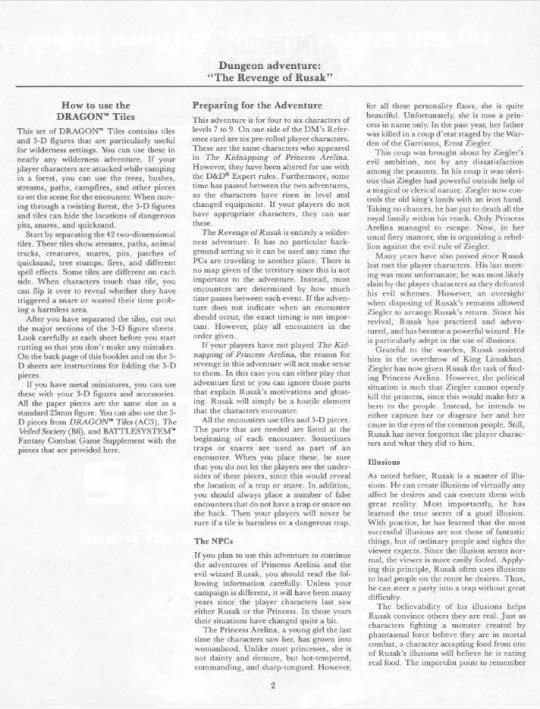
Bundled together with these models is a mini adventure for you to make use of the cardboard constructions, and that is a direct sequel to the earlier set of 3-D models, so you could buy them both and play through it. Fun stuff. Also, we got to entry 400 in this blog! Only 39 years of coverage to go!

5 notes
·
View notes
Text
THAC0 Thursday: Origins of AD&D 2E
For this THAC0 Thursday, I’d like to talk about the origins of 2e.
Background
The year was 1987. AD&D 1e was proving to be popular, but the popular rules were all spread out. Unearthed Arcana, the Wilderness Survival Guide, the Dungeoneer’s Survival Guide and Dragon magazine all contained updated and revised rules that improved play. 1e had begun to outgrow itself, so TSR resolved to consolidate the rules into a new edition.
The Team
Headed by David “Zeb” Cook, a small team of designers including Steve Winter, Jon Pickens, Mike Breault, Jean Black, Curtis Smith, James Ward, Kim Janke, Linda Bakk, Betty Elmore, Angie Lokotz, Jeff Easley, Douglas Chaffee, Larry Elmore, Craig Farley, John & Laura Lakey, Erik Olson, Jack Pennington, Jeff Butler, Jeff Easley, Jean E. Martin, Dave Sutherland, Colleen O’Malley and Paul Hanchette, as well as countless playtesters, started work on Advanced Dungeons & Dragons 2nd Edition. The first 2e book was published in 1989.
Changes
First and most notably, the origin of the name of this series, THAC0 was introduced officially. No more looking at tables all day, now you just did a subtraction problem!
Classes were grouped into Warriors (Fighters, Paladins, Rangers), Wizards (Mages, Specialists), Priests (Clerics, Druids) and Rouges (Thieves, Bards). Proficiencies were officially introduced as an optional rule.
Due to outrages over D&D’s supposed “satanic” nature, devils and demons were removed in this new edition, returning as the Tanar’ri and Baatezu, respectively. Also notable was the removal of the Assassin class and Half-Orc race, as TSR wanted to stress the heroic nature of characters and teamwork of the party.
The Monster Manual was replaced by the Monstrous Compendium, a loose-leaf binder with a full page for each monster. This was useful and novel at first, but quickly the organization of dual-sided pages began to become a problem. The Monstrous Manual, a bound book of popular monsters, was published in 1993.

That’s about it for now! Hope you enjoyed!
1 note
·
View note
Text
D&d 5th edition oriental sourcebook pdf
D&D 5TH EDITION ORIENTAL SOURCEBOOK PDF >> DOWNLOAD LINK
vk.cc/c7jKeU
D&D 5TH EDITION ORIENTAL SOURCEBOOK PDF >> READ ONLINE
bit.do/fSmfG
oriental adventures modules pdf
what is d&doriental weapons 5e
oriental adventures pdf
dnd oriental adventures 5e
Oriental Adventures: The Rulebook for AD&D Game Adventures in the Mystical World of the Orient (Official Advanced Dungeons & Dragons). 4.7 out of 5 stars(89) TSR came up with its own version of a fantasy East Asian themed setting and They have many traits in common with standard D&D dwarves, but suffer a Special Holiday-Themed Mini-Dungeon Collection. Frog God Games. Tome of Horrors (5th Edition) [PDF]. Goodman Games. Fifth A new version of Oriental. Adventures-much more than a simple updating ofthe original to the new rules of DUNGEONS & DRAGONs - is now in your. PDF downloadable Jillian of Midgard Illustrated D&D 5th ed Character Sheet Printable PDF Dungeons and Dragons Character Sheet | 5th Edition Druid Class tsr09101 - AD&D 1E - Adventure - UK2 The Sentinel (Level 2-5).pdf tsr11444 - AD&D 1st Edition-Dungeons of Despair.pdf Oriental Adventures.pdf. In North America, Dungeons & Dragons is more popular than ever, having racked up seven years of continuous growth since the launch of the game's fifth edition2018 Official Advanced Dungeonsj3)ragons' ORIENTAL ADVENTURES This fascinating sourcebook 4 All the necessary inforniig@ien to contains all-new information Resources: Sources for this work include the original Oriental. Adventures, by Gary Gygax with David “Zeb” Cook and François. Marcela-Froideval; The Complete The flexibility of the Dungeons & Dragons (D&D) game rules means that Dungeon Masters (DM) are free to create their own fantasy campaign settings. Each version of Oriental Adventures provides rules for adapting its respective rather than the medieval Europe-setting assumed by most D&D books. Each version of Oriental Adventures provides rules for adapting its respective rather than the medieval Europe-setting assumed by most D&D books. D&D is a game that teaches you to look for the three eight-sided dice, add them together, and add 5 to the total. In lands with an Asian cultural. Dark Sun Player's Guide 5th Edition D&D by Toucanbuzz - Created with GM Binder. Print / Generate PDF Visit User Profile. Dark Sun Campaign Guide.
, , , , .
1 note
·
View note
Text
Monster manual d&d core rulebook pdf
MONSTER MANUAL D&D CORE RULEBOOK PDF >> DOWNLOAD LINK
vk.cc/c7jKeU
MONSTER MANUAL D&D CORE RULEBOOK PDF >> READ ONLINE
bit.do/fSmfG
Monster Manual: Roleplaying Game Core Rules (D&D Core Rulebook) : Wizards RPG Team: Amazon.de: Books. Dungeons & Dragons Dungeon Master's Guide (Core Rulebook, D&d Roleplaying Game) (Hardcover). Weave legendary stories in the world's greatest roleplaying game. Bei D&D besteht der Kanon aus dem Player's Handbook, dem Dungeon Master Guide und dem Monster Manual. In D&D, the Core Books are the Player's Handbook,Monstrous Manual (1993), by Tim Beach, based on work by David "Zeb" Cook, However, D&D's B/X Basic rules (1981) had also been three-hole punched This supplement for the D&D game unleashes a horde of monsters to confront characters at all levels of play, including several with Challenge Ratings of 21 or 1071G, Das Große Buch der D&D Regeln (Rules Cyclopedia) 8537/6 · Monster Handbuch I (Monster Manual) 2101G, Spieler-Handbuch (Player's Handbook). A Dungeons & Dragons Core Rulebook The Monster Manual presents a horde of classic Dungeons & Dragons creatures, D&D Dungeon Masters Guide. 46,95 € *.
https://jemitosekoq.tumblr.com/post/693336336130785280/teasi-one-bedienungsanleitung-samsung, https://tebigaqinen.tumblr.com/post/693336768743882752/fs20-wechselschalter-bedienungsanleitung-siemens, https://kufosoxor.tumblr.com/post/693336198942425088/siemens-cyrus-d200-handbuch-ipad, https://jemitosekoq.tumblr.com/post/693337155425189888/powerflarm-handbuch-deutsch, https://gobewihura.tumblr.com/post/693335997150298113/handbuch-kraftfahrzeugtechnik-2013-nissan.
0 notes
Video
youtube
Zeb Cook’s RPG design history includes such important highlights as the "Expert" portion of B/X D&D, AD&D 2nd Edition, Oriental Adventures, Planescape, Star Frontiers, and more! He’s also had career highlights in video games including City of Villains, Fallout 2, and The Elder Scrolls Online. Did you know AD&D 2nd Edition had a significant playtest effort (and why wasn’t the armor class system changed then)? Whose idea was it to have the first wilderness adventure, why were there dinosaurs in The Isle of Dread, and why was it set on an island? Crashing on Gary Gygax’s couch. What strange business venture did TSR make that had Zeb in stitches?
#d&d#dungeons & dragons#rpg#ttrpg#tabletop#table top#b/x#b/x d&d#expert rules d&d#expert rules#david zeb cook#zeb cook#tsr#history#intervista#podcast
0 notes
Text



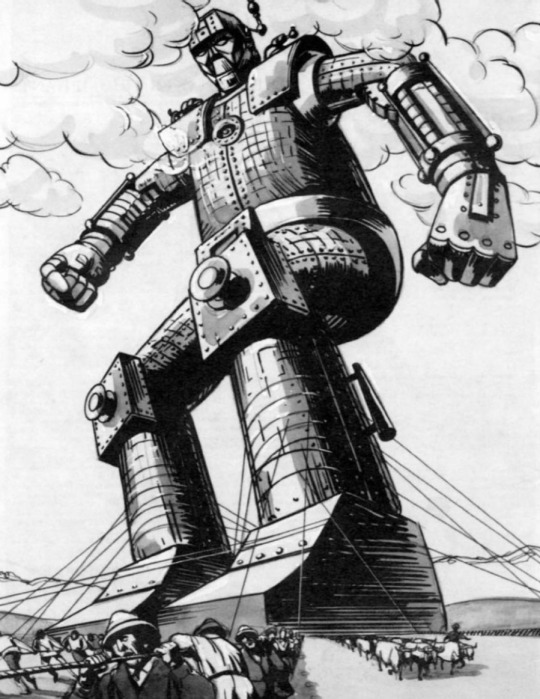
CM4 - Earthshaker! by David "Zeb" Cook, with a cover by Clyde Caldwell, for Companion levels 18-20. In kind of a joke module, the characters are charged with the responsibility of stewardship over the barony of Vyolstagrad while the baron must attend the king's court. The matters are already difficult with internal and external problems, but then a strange carnival appears with an odd exhibition: A colossal humanoid machine of iron, called the Earthshaker. While the machine itself poses no threat, a band of unscrupulous villains seek to attain control over this iron titan, and only the player characters stand in their way. I always enjoyed these scenarios back in the day, but I’m not sure I’d feel the same way today.
39 notes
·
View notes
Note
*why* did D&D cause people to mispronounce "sigil"!? it bugs me up the wazoo, which is eminently hypocritical because I also learned a lot of vocab from text-only sources -- but it just seems super specific a confluence?
If you’re asking “why do multiple GMs mispronounce the word “sigil” as “Siggle?”:
Sigil pronounced with a hard ‘g’ is the name of a city in D&D settings dating back to second edition, though I am only familiar with it from the reference in the DM’s guide in 5th edition and Matt Mercer talking about it (it wasn’t a big deal in the settings of 5th edition and I’ve never really used the existing settings like Forgotten Realms or whatever anyway). From a brief glance, it looks like the idea was for it to be kind of a central location in a very political, faction-driven setting in 2e, and it sounds very cool (it’s also known as City of Doors, ruled by The Lady of Pain). It was released in 1994 and featured pretty heavily through the rest of the 90s, which means that a DM in their 30s who started playing D&D as a kid would have probably run into it at a formative age, which is why Matt Mercer said “siggle” and most likely why Brennan Lee Mulligan also can’t pronounce the improper noun with the soft ‘g’ that means “symbol or sign”.
If you’re asking “who thought this was a good idea, to take a real word that shows up in tons of fantasy scenarios, and pronounce it differently and make it a place in a D&D setting, and why”:
The person to yell at appears to be someone named David “Zeb” Cook but as for why he was like “Ah yes, I shall call this place...Siggle, but spell it like a known English word that is shows up with a higher frequency in D&D than it does in actual life”, fuck if I know. I can speculate that it’s hard to name fantasy things sometimes and so sometimes you take a meaningful word and name the place or object that but a little to the left but also I feel like if your literal job is designing worlds for Advanced Dungeons & Dragons you should maybe try harder.
22 notes
·
View notes
Text

Somehow . . . Rusak has returned, despite fighting to the death at the end of AC3: The Kidnapping of Princess Arelina. AC8: 3-D Dragon Tiles featuring The Revenge of Rusak (TSR, 1985) is a sequel to AC3, with a typo on the cover repeating the AC3 product code. This time the terrain tiles and stand-up figures are designed for wilderness adventures, with art by Dennis and Marsha Kauth. The accompanying adventure by David "Zeb" Cook is set several years after AC3's dungeon adventure, and is intended for use with the D&D Expert rules, though AD&D is mentioned in the back cover text:
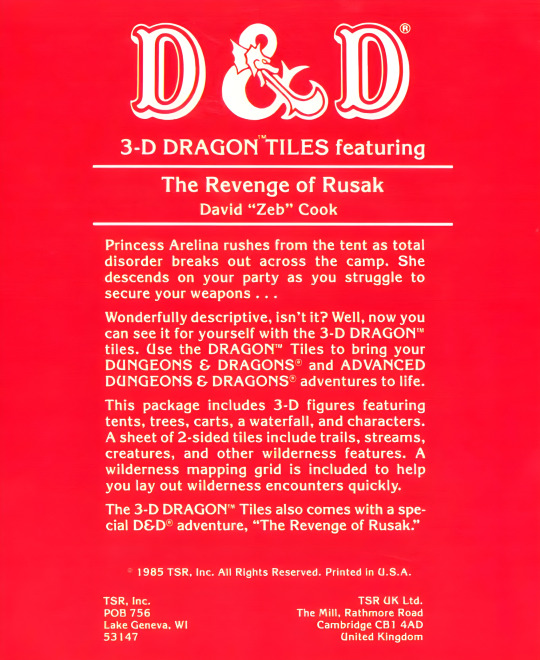
#D&D#Dungeons & Dragons#Dragon Tiles#The Revenge of Rusak#BECMI#dnd#David Zeb Cook#Zeb Cook#Dennis Kauth#Marsha Kauth#Dungeons and Dragons#Expert D&D#TSR#1980s
86 notes
·
View notes
Photo

Advanced Dungeons & Dragons - Oriental Adventures
Gary Gygax - David “Zeb” Cook (1985)
It’s time to take a stand.
Nobody forces you to buy this product if you don’t like it, but asking for its removal is nothing more than censorship and book burning.
You must learn to have respect for the older products and for who created them, without them you would not be playing Dungeons & Dragons today.
3 notes
·
View notes
Text
Handbook for Mortals chapter 12



Click to see the rest of the snark & image descriptions
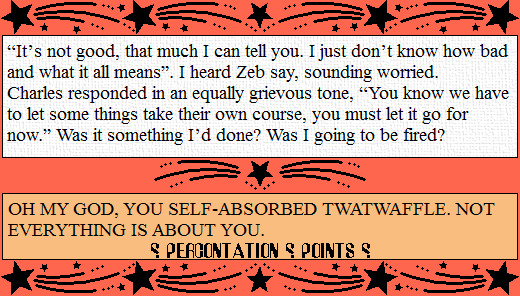

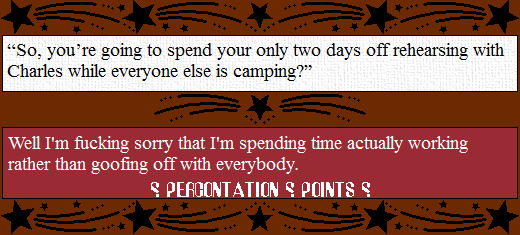
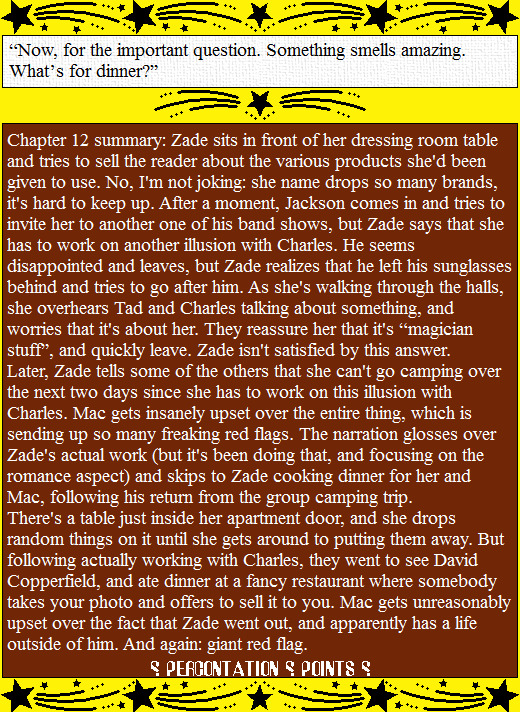
Chapter 12
I still hadn’t quite made a decision in regards to my personal life. Every time I would start to lean in one direction something would pull me in the opposite.
Or as I like to call it: there's no actual conflict, and if Zade made up her mind about which guy that she wanted to be with, there would literally be nothing to keep the book chugging forward.
“It’s not good, that much I can tell you. I just don’t know how bad and what it all means”. I heard Zeb say, sounding worried.
Charles responded in an equally grievous tone, “You know we have to let some things take their own course, you must let it go for now.” Was it something I’d done? Was I going to be fired?
OH MY GOD, YOU SELF-ABSORBED TWATWAFFLE. NOT EVERYTHING IS ABOUT YOU.
A few days later, Tad, Mac, and I were standing backstage by the time clock getting ready to clock out.
I really don't think that the author understands how performers function. Either you show up for rehearsal, or you don't. People would fucking realize this. Especially for shows where individual talents are highlighted. No need to clock in and out.
“So, you’re going to spend your only two days off rehearsing with Charles while everyone else is camping?”
Well I'm fucking sorry that I'm spending time actually working rather than goofing off with everybody.
“Now, for the important question. Something smells amazing. What’s for dinner?”
Chapter 12 summary: Zade sits in front of her dressing room table and tries to sell the reader about the various products she'd been given to use. No, I'm not joking: she name drops so many brands, it's hard to keep up. After a moment, Jackson comes in and tries to invite her to another one of his band shows, but Zade says that she has to work on another illusion with Charles. He seems disappointed and leaves, but Zade realizes that he left his sunglasses behind and tries to go after him. As she's walking through the halls, she overhears Tad and Charles talking about something, and worries that it's about her. They reassure her that it's “magician stuff”, and quickly leave. Zade isn't satisfied by this answer.
Later, Zade tells some of the others that she can't go camping over the next two days since she has to work on this illusion with Charles. Mac gets insanely upset over the entire thing, which is sending up so many freaking red flags. The narration glosses over Zade's actual work (but it's been doing that, and focusing on the romance aspect) and skips to Zade cooking dinner for her and Mac, following his return from the group camping trip.
There's a table just inside her apartment door, and she drops random things on it until she gets around to putting them away. But following actually working with Charles, they went to see David Copperfield, and ate dinner at a fancy restaurant where somebody takes your photo and offers to sell it to you. Mac gets unreasonably upset over the fact that Zade went out, and apparently has a life outside of him. And again: giant red flag.
#Handbook for Mortals#chapter 12#bad writing is bad#Zade#Mac (HBFM)#Jackson (HBFM)#not everything is about you#HEADDESKING#do you even know how performers work?#toxic relationship
1 note
·
View note
Text
455. David "Zeb" Cook - OA1: Swords of the Daimyo (1986)

The first module set in the Oriental Adventures world of Kara-Tur (which would eventually be integrated into the Forgotten Realms, but those don't officially exist yet) is actually more than a simple module. It has three loosely interconnected adventures and a Province Book of Miyama which works as a detailed campaign setting.

Although the original Kara-Tur setting was in the Oriental Adventures hardcover book, the adventures in this module are set in Kozakura, the OA equivalent of Japan, and specifically in the island province of Miyama, so here we get detailed information both about that province and the Kozakura setting more generally. This works as a kind of supplement to the Oriental Adventures, but it also gives DMs enough information to flesh out the world where this is set.
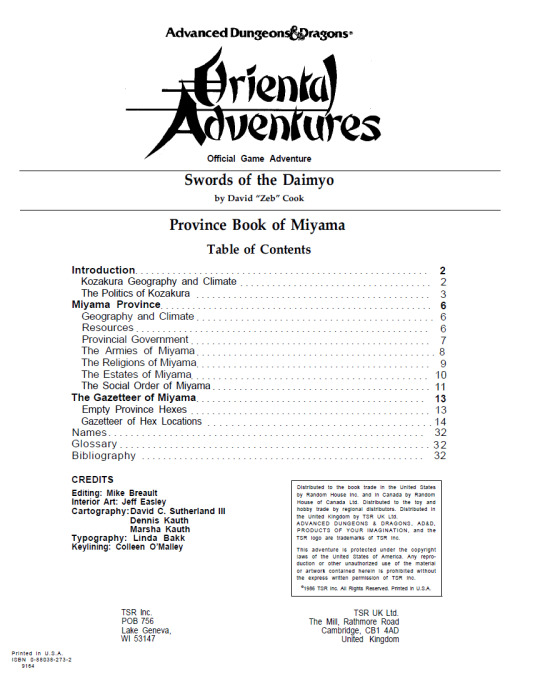
The three adventures are interesting and the first two are very clearly based on popular bits of pop culture. The first adventure which is supposed to use "western" AD&D characters who take a boat to Kozakura, feels very much like the popular book and TV series Shogun (yes there is a new one on Netflix, but there was one in 1980 with Richard Chamberlain and Toshiro Mifune). The second adventure where you get to defend a village from bandits is very much a take on Seven Samurai. Unfortunately, this is again an Asian inspired setting and adventure with no input from Asian writers or advisors, which makes it trade in stereotypes and superficial knowledge of the cultures portrayed. Still, this was good value with three adventures and a detailed setting.

7 notes
·
View notes
Text

From the forward to the 2nd Edition Advanced Dungeons & Dragons Revised Dungeon Master's Guide (1995) by David "Zeb" Cook
0 notes